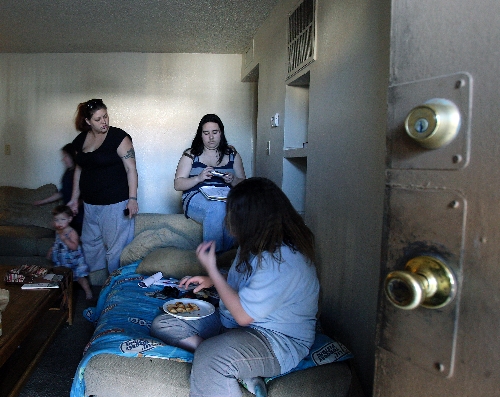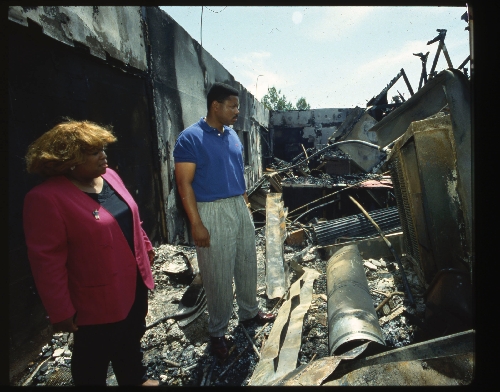Residents look forward to demolition of troubled apartment complex







Buena Vista Springs is dying and no one — not even the people who still live there — seems particularly torn up about it.
The long-troubled apartment complex, built in 1965, has in recent decades brought nothing but headaches to police, city officials and neighbors in its North Las Vegas community. Gangs, crime and decay have long been the complex’s main tenants.
Much of Buena Vista, whose core campus sits crumbling on Carey Avenue, just west of Martin Luther King Boulevard, is boarded up, fenced off and deemed uninhabitable by officials.
Its cheerless playground, dusty and deteriorating, is abandoned, though plenty of children live in the complex. You would have to get past a 6-foot-high chain-link fence to use the slide.
Forty-two of Buena Vista’s 288 units remain rented out, many to people who, it seems, have nowhere else to go.
City officials for years have wanted to flatten the development, hoping its unrelenting crime and dysfunction would die with it.
Federal officials in 2009 rejected a $7.6 million plan crafted by Clark County and North Las Vegas officials to demolish the complex because the funding was meant to help fight Southern Nevada’s foreclosure crisis. Buena Vista had yet to be foreclosed on.
That foreclosure finally came late last year, and city officials are hoping a new, $6.85 million plan to demolish the property will be approved in the latest round of federal Neighborhood Stabilization Program funds. The plan, which has been approved by city and county elected officials, is due to the U.S. Department of Housing and Urban Development by March 1.
"Our hopes were dashed big-time" in 2009, Kathy Somers, neighborhood services manager for North Las Vegas, said Monday while touring Buena Vista. "Now, the timing just seems right."
Somers shook her head when she came upon the swingless playground.
"When you look around, it’s overwhelming," she said. "It has such a sad feeling."
From prime to decline
It’s hard now to believe that Buena Vista Springs, in its youth, was a neighborhood oasis. Children from all over the community gathered on the playground for baseball and football games. Their parents enjoyed the parklike atmosphere.
"Things were green," Somers said. "There were trees and bushes."
Letha Whalum, who has lived nearly five decades in a home less than a half mile from Buena Vista, has fond memories of the complex’s early days.
"It was beautiful," she said. "There were no drugs. It had a wonderful park. They had things for the kids to do."
Whalum, 71, sent her five children, all now grown, to nursery school at Buena Vista.
But the complex aged and faded quickly. Owners came and went. Repairs went undone. Vandalism was a recurring problem.
By the late 1970s, neighbors and residents were complaining about the complex’s vandalized and burned-out living units, and the city was searching for a long-term solution that didn’t materialize.
Buena Vista has been in decline for decades, Whalum said, and it’s time for it to go.
"It’s gone from worse to bad to nothing," she said. "It’s just an eyesore. It needs to be torn down."
Mayor Shari Buck said the complex passed through the hands of several different owners "who didn’t really care to keep it up and looking nice."
"If you’re not taking care of it, people don’t take pride in it," she said.
Both of Buena Vista’s campuses — the second comprises 72 units on Lake Mead Boulevard at Comstock Drive — have been "rife with crime and vandalism" and "plagued by continued code enforcement and building safety violations" for many years, according to the city’s and county’s joint application for HUD funds.
The application notes that mold, lead and asbestos contamination are suspected at Buena Vista.
The complex’s long decline culminated in a massive relocation of its roughly 1,000 residents in 2007 after HUD officials yanked subsidies for low-income tenants there, saying the apartments were unsafe and unsanitary and had failed several inspections.
But the owners soon started renting out the units again. Calls to police from the complex resumed.
The eyesore remained.
Police move in
As Buena Vista Springs deteriorated, the criminal element thrived.
The complex, which until 1994 was known as Carey Arms, became notorious for being virtually controlled by gang members. It was surrounded by warring gangs. Drug sales, drive-by shootings, vandalism and robberies were common in the apartments and surrounding neighborhood, which was known as "40-Block" after 40-ounce malt liquor bottles.
"The drug dealing and gang problems out of there made the number of homicides real high," said Sgt. Tim Bedwell, a North Las Vegas police spokesman. "Some of the homicides were people involved in the illegal activity. Some were just innocent people caught up in the action."
About dusk on April 30, 1992, the day of the Rodney King verdict in Los Angeles, Carey Arms residents heard shouts and the pops of gunfire coming from outside. Teenagers and young adults gathered in the courtyard.
By the next day, the complex’s administration building was destroyed by fire.
Community leaders formed groups to attack the problems of crime and joblessness in the area.
In 1994, under new ownership, buildings in the complex were painted. Units were given new carpet and appliances. A new administration building was constructed, and Carey Arms became Buena Vista Springs.
But the complex’s problems were deep-seated and stubborn. It remained such a challenge for law enforcement that North Las Vegas police in 2001 opened a "problem-solving unit" right on the property. They began building stronger relationships with residents, and their constant presence discouraged crime.
"It gave us the opportunity to build trust with the people who lived there," Bedwell said. "People began calling us right away instead of three hours later. There was still more crime than there should be, but we were doing much better."
The unit remained open at Buena Vista until 2007. Crime plummeted when everybody moved out in the large-scale relocation, and the surrounding neighborhood got a reprieve. There were fewer break-ins and less vandalism.
City officials worked to revitalize the neighborhood of older single-family homes and allocated federal funding for the purpose. Graffiti was quickly cleaned up and the streets were swept more often, Whalum said.
The number of police calls began climbing again when renters started moving back in. But with so many units boarded up, "we don’t have that central, very dense hub of gang and drug activity we had before," Bedwell said.
"Right now, the calls over there are consistent with the neighborhood that surrounds it. It’s been nothing like it was when it was very bad."
New residents
But things haven’t changed enough, said Gabrielle Villalba, a 31-year-old mother of five who has lived at Buena Vista Springs nearly two years.
Since Villalba, who is pregnant with a sixth child, moved into a three-bedroom apartment with her children and parents, it seems like the parking lot has been blocked by police tape "about once a week because somebody’s been stabbed, murdered or raped," she said.
"My kids were outside in the middle of the day when there was a shooting. I rounded them up and got them inside."
One of her children, the 14-year-old, got mugged while walking home from the store. The mugger got away with $8.
Villalba, who pays $735 a month in rent, said several different managers have handled the apartments since she moved in.
"When something breaks, you have to wait for a new manager to get it fixed," she said.
Asked whether she had heard that the city would like to demolish the place, her 13-year-old daughter chimed in.
"I’m glad they are," the girl said. "There are too many shootings."
Another resident, a 55-year-old woman who declined to give her name, agreed Buena Vista should be razed.
"As you can see, it has got to be restructured," she said, gesturing toward the boarded up buildings just feet from her front door. "Hopefully, I’ll end up in a cleaner, healthier environment."
Both women said they wound up at Buena Vista because they had no place else to go. In Villalba’s case, having no credit history disqualified her from many rentals.
"They took a chance on me here," she said.
The older woman said her apartment was provided by a program that helps women who have been incarcerated or struggled with substance abuse .
"Obviously, I had a different vision for my life," she said.
Clark County Commissioner Lawrence Weekly, whose district includes Buena Vista, said the complex — at least in the past — required no background checks or credit history for renters.
"With no criteria to be able to live there, you get what you pay for," Weekly said.
Now, the residents are mostly single mothers "who really want to do better," he said.
Buck said over the years "whenever new owners came in, they always promised to do background and credit checks, and they never did."
Both believe demolishing the complex is the best hope for the neighborhood.
"We can tear it down and put something new there," Buck said. "We can get rid of a terrible blight with a troubled past."
The plan
North Las Vegas officials are hoping HUD approves their new plan to purchase Buena Vista Springs, demolish it and "land bank" the property until an affordable-housing redevelopment project can be developed and financed.
The $6.85 million comes from federal Neighborhood Stabilization Program funds awarded to the city, county and state. The city’s portion comes to nearly $3.7 million. The budget includes $2.4 million for relocating the current residents, who may be eligible for up to 60 months of relocation assistance, Somers said.
The earlier plan, which federal officials rejected in 2009, stirred controversy in part because it would demolish the complex but provide no funding for redevelopment of the land.
The new plan doesn’t include money for redevelopment, either. But officials are confident that money soon will come from somewhere.
"I think you’ll see a lot of interest in doing something on that land," Buck said, adding that private developers may be interested.
Officials will "aggressively go after federal funds to put affordable single-family housing in place" on the land, Weekly said.
Just getting rid of Buena Vista will go a long way toward improving the neighborhood, Somers said.
"Part of stabilizing neighborhoods is demolishing blights," she said. "Just taking it down will have a dramatic impact on the community."
The application to HUD puts the argument more succinctly: "Demolition of this project will immediately relieve the community of an eyesore which is a source of crime, extremely poor, unhealthy, unsafe conditions and a drain on an already economically distressed neighborhood."
But even without Buena Vista, the neighborhood will still face challenges.
"It’s a mature part of town and a poorer part of town," Bedwell said.
Whalum, who plans to stay put in the home in which she has lived for decades, acknowledges those challenges, but said she doesn’t let them get her down.
"A neighborhood or a house don’t make you," she said.
Contact reporter Lynnette Curtis at lcurtis@reviewjournal.com or 702-383-0285.












